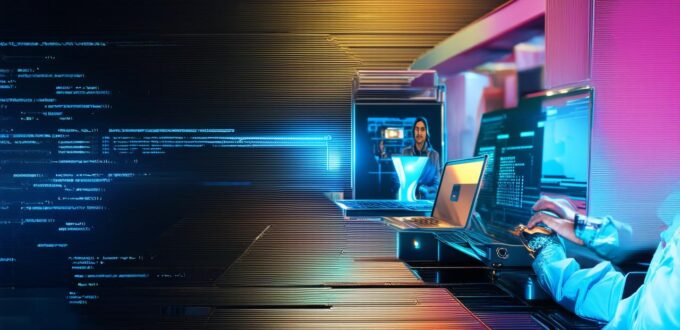Introduction
Before diving into the main topic, let’s first define what general software and application software are. General software refers to a collection of programs or utilities that perform various tasks on a computer system. Examples of general software include operating systems, file management systems, and other utility programs like antivirus software, web browsers, and email clients.
On the other hand, application software refers to a program designed for a specific purpose, typically for end-users. Examples of application software include word processors, spreadsheets, graphic design tools, video editors, and games. Application software is usually more user-friendly than general software and is designed to perform a specific task or set of tasks.
The Differences Between General Software and Application Software
Purpose
One of the key differences between general software and application software lies in their purpose. General software is primarily designed to support and manage the overall functionality of a computer system, while application software is created for end-users to perform specific tasks.
Functionality
Another difference between general software and application software lies in their functionality. General software is designed to be modular and flexible, allowing it to adapt to changing computer systems and provide support for new applications as they are developed.
Application software, on the other hand, is more specialized and focused on providing a specific set of features to its users. It may have limited compatibility with other programs or operating systems, requiring additional software or drivers to run effectively.
Target Audience
The target audience for general software and application software also differs. General software is designed for system administrators, developers, and other technical professionals who need to manage the overall functionality of a computer system. It is typically more complex and requires specialized knowledge to use effectively.
Application software, on the other hand, is designed for end-users who need to perform specific tasks, such as writing documents, creating graphics, or editing videos. It is typically more user-friendly and accessible to a wider audience.
Case Studies and Personal Experiences
General Software: Microsoft Windows
Microsoft Windows is an example of general software that provides essential services to other programs and manages the resources on a computer system. It is designed for technical professionals who need to manage the overall functionality of a computer system, such as network administrators, developers, and system analysts.
Windows provides support for multiple applications and allows them to run simultaneously on the same computer system. It also provides security features that protect the system from malware and other threats. However, it requires specialized knowledge to use effectively and can be complex for end-users.
Application Software: Photoshop
Photoshop is an example of application software designed for end-users to perform specific tasks, such as graphic design. It provides a set of features tailored to meet the needs of its target audience, including tools for image editing, color correction, and image manipulation.
Photoshop is typically more user-friendly than general software like Windows and requires less specialized knowledge to use effectively. However, it may have limited compatibility with other programs or operating systems and require additional software or drivers to run effectively.
Expert Opinions and Research
Expert Opinion: Michael Nielsen
Michael Nielsen is a renowned usability expert who has written extensively on the subject of user experience design. In his book “Don’t Make Me Think,” he discusses the importance of designing software that is easy to use and accessible to all users, regardless of their technical expertise.
According to Nielsen, application software should be designed with a focus on simplicity and ease of use, while general software can be more complex and require specialized knowledge to use effectively. He emphasizes the importance of designing software that is intuitive, consistent, and easy to navigate, regardless of the user’s technical expertise.
Research: Gartner
Gartner, a leading research and consulting firm, conducted a survey of software development professionals to determine their views on general software and application software. The survey found that while both categories are important for modern technology, application software is considered more critical than general software in today’s business environment.
The survey respondents cited the need for software that is easy to use and provides specific solutions to their business needs as key factors in choosing application software over general software. They also emphasized the importance of integration with other systems and the ability to customize software to meet their unique requirements.
Real-Life Examples
General Software: Microsoft Office

Microsoft Office is an example of general software that provides a suite of applications for office tasks, such as word processing, spreadsheets, and presentations. It is designed for end-users who need to perform specific tasks within their businesses, such as creating documents, managing finances, or presenting information.
While Microsoft Office is user-friendly and accessible to a wide audience, it may not provide the level of customization and integration required by some businesses. Additionally, it requires additional software or drivers to run effectively on some operating systems.
Application Software: Salesforce CRM
Salesforce CRM is an example of application software designed for end-users in the business world. It provides a set of features tailored to meet the needs of sales and marketing professionals, including lead management, contact tracking, and pipeline analysis.
Salesforce CRM is highly customizable and integrates with other systems, such as email and social media platforms, providing a comprehensive solution for managing sales and marketing tasks. It also provides real-time analytics that help businesses make data-driven decisions.
Conclusion
In conclusion, general software and application software differ in their purpose, functionality, and target audience. General software is designed to support and manage the overall functionality of a computer system, while application software is created for end-users to perform specific tasks.
While both categories are important for modern technology, application software is considered more critical than general software in today’s business environment due to its ability to provide specific solutions to business needs and integrate with other systems. By understanding the differences between general software and application software, businesses can make informed decisions about which type of software is best suited to their unique requirements.
